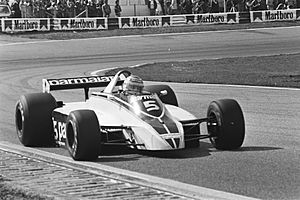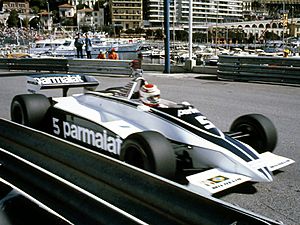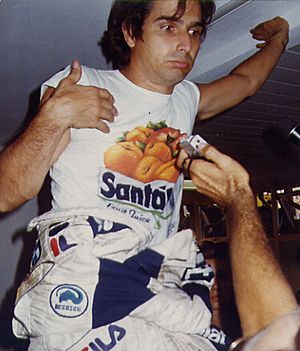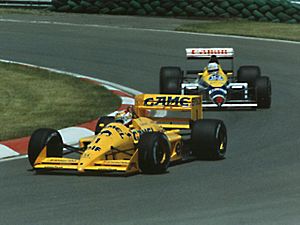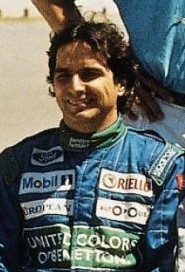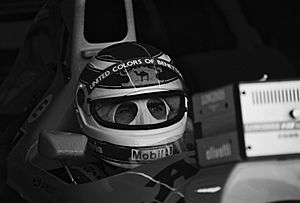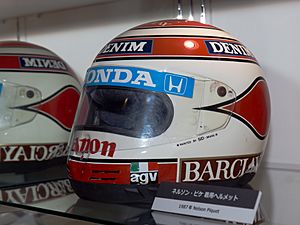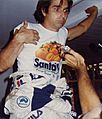Nelson Piquet facts for kids
Quick facts for kids
Nelson Piquet
|
|
|---|---|

Piquet in 2022
|
|
| Born |
Nelson Piquet Souto Maior
17 August 1952 Rio de Janeiro, Brazil
|
| Spouse(s) |
Maria Clara
(m. 1977; div. 1978)Sylvia Tamsma
(m. 1978; div. 1993)Viviane de Souza Leão
(m. 1998) |
| Children | 6, including Nelson Jr., Kelly and Pedro |
| Formula One World Championship career | |
| Nationality | |
| Active years | 1978–1991 |
| Teams | Ensign, BS Fabrications, Brabham, Williams, Lotus, Benetton |
| Entries | 207 (204 starts) |
| Championships | 3 (1981, 1983, 1987) |
| Wins | 23 |
| Podiums | 60 |
| Career points | 481.5 (485.5) |
| Pole positions | 24 |
| Fastest laps | 23 |
| First entry | 1978 German Grand Prix |
| First win | 1980 United States Grand Prix West |
| Last win | 1991 Canadian Grand Prix |
| Last entry | 1991 Australian Grand Prix |
| 24 Hours of Le Mans career | |
| Years | 1996–1997 |
| Teams | BMW |
| Best finish | 8th (1996) |
| Class wins | 0 |
Nelson Piquet Souto Maior (born on August 17, 1952) is a Brazilian former racing driver and businessman. He competed in Formula One from 1978 to 1991. Piquet won three Formula One World Drivers' Championship titles in 1981, 1983, and 1987. He also won 23 Grand Prix races during his 14 seasons.
Piquet first played tennis but then became interested in karting. He even used a different name to keep his hobby a secret from his father. He became the Brazilian national karting champion in 1971–72. In 1976, he won the Formula Vee Brazil championship. With advice from Emerson Fittipaldi, Piquet went to Europe. There, he set a record for the most wins in Formula Three in 1978, beating Jackie Stewart's old record.
In 1978, he made his Formula One debut with the Ensign team. He also drove for McLaren and Brabham. In 1979, Piquet joined the Brabham team. He finished second in the championship in 1980 before winning his first title in 1981. In 1982, Piquet faced many engine problems. But he came back strong in 1983 to win his second world championship. From 1984 to 1985, Piquet had fewer chances to win the championship but still managed three wins. He moved to the Williams team in 1986 and fought for the title until the very last race. Piquet won his third and final championship in 1987 after a tough battle with his teammate Nigel Mansell. This rivalry made their relationship difficult. Piquet then moved to Lotus for 1988–89, where his performance dropped. He later joined the Benetton team for 1990–91, winning three more races before he retired.
After leaving Formula One, Piquet raced in the Indianapolis 500 for two years. He also competed in sports car races during and after his Formula One career. Piquet is now retired and runs several businesses in Brazil.
Contents
Early Life and Racing Start
Piquet was born on August 17, 1952, in Rio de Janeiro, Brazil. His father was a doctor who later became the Minister for Health in Brazil. Piquet was the youngest of four children.
His father wanted Piquet to be a professional tennis player. Piquet started playing tennis at age 11 and even won tournaments in Brazil. He also traveled to California to play against American players. During this time, he learned English and grew up a lot. While he was a good tennis player, he wasn't seen as exciting enough for the sport. This led him to focus on motor racing instead.
Piquet began kart racing when he was 14. Because his father didn't approve of racing, he used his mother's maiden name, Piquet, to hide his identity.
In 1974, Piquet left university after two years of studying engineering. He then worked in a garage to pay for his racing career, as his family didn't support him financially.
When he returned to Brazil, Piquet and three friends bought a go-kart. He became the national go-karting champion in 1971 and 1972. He also won the local Formula Super Vee championship in 1976. Emerson Fittipaldi, the first Brazilian Formula One world champion, advised Piquet to go to Europe. In 1978, Piquet broke Jackie Stewart's record for the most wins in a single season in British Formula 3.
Formula One Career
Piquet made his Formula One debut for Ensign at the German Grand Prix in 1978. He started 21st but had to stop early due to engine trouble. After that race, Piquet drove a McLaren for BS Fabrications in three more races, leaving a good impression. His best finish was ninth place in Italy.
Brabham Team (1978–1985)
For the last race of 1978, Piquet joined the Brabham team. He qualified 14th and finished 11th. Piquet stayed with Brabham until 1985.
First Full Season: 1979
In 1979, Piquet raced his first full Formula One season with Brabham, alongside two-time world champion Niki Lauda. It was a tough year for the team. Piquet had to retire from 11 of the 15 races. He scored his first career points at the Dutch Grand Prix, finishing fourth. He also had a big crash at the Italian Grand Prix but was not hurt. Even with car problems, Piquet often qualified well, sometimes even better than Lauda. Lauda suddenly left racing before the Canadian Grand Prix. This made Piquet the main driver for Brabham. In the final race, Piquet started near the front and set the fastest lap, showing the new car's potential.
Championship Challenge: 1980
In 1980, Piquet finished second in Argentina. He then won his first race at the United States Grand Prix West in Long Beach, California. Five months later, Piquet won two races in a row in the Netherlands and Italy. He finished second in the drivers' championship, 13 points behind the winner, Alan Jones.
First World Title: 1981
The 1981 season started with some rule changes. After finishing third in the United States Grand Prix West, Piquet started from pole position at his home race in Brazil. However, he struggled because he used slick tires on a wet track. At the next race in Argentina, Brabham found a clever way around a new rule about car height. This made their car very fast, and Piquet easily won. Other teams soon copied this idea. Piquet also won the San Marino Grand Prix despite rain.
Piquet won the championship with an amazing comeback. He won the German Grand Prix and then consistently scored points. He went into the last race of the season, the Caesars Palace Grand Prix in Las Vegas, just one point behind the leader. Piquet finished fifth in that race, which was enough to win his first world title. He was so tired from the heat and the track that he had to be helped out of his car.
Engine Troubles and Second Title: 1982-1983
In 1982, Piquet was fast, but his car often broke down. Brabham had teamed up with BMW for powerful but unreliable turbocharged engines. Piquet won the Brazilian Grand Prix in Rio de Janeiro. The extreme heat made him faint on the podium. He was later disqualified because his car was too light. His only official win that year was in the Canadian Grand Prix, which was BMW's first Formula One win.
In 1983, Piquet won the first race in Brazil. He then got two second-place finishes in France and Monaco. With three races left, he was 14 points behind Alain Prost. But Piquet won the next two races in Italy and Brands Hatch, closing the gap to just two points. At the final race in South Africa, Prost retired, and Piquet finished third, winning his second world title. This was also the first time a turbocharged car won the championship.
Pole Positions and Challenges: 1984-1985
In 1984, new rules limited fuel tank size. Many thought Piquet would be a favorite because his BMW engine was expected to be more fuel-efficient. He set a record for pole positions that year, starting from the front nine times.
The season was dominated by the McLaren team. Piquet won in Canada, even though he suffered burns on his foot from the hot car. He won again in Detroit. These were his only two wins that year. He finished fifth in the championship.
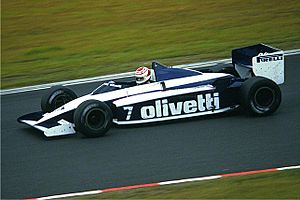
In 1985, Piquet won only one race, the French Grand Prix. He was becoming frustrated with Brabham. He felt his loyalty was being taken for granted, and his salary was lower than other top drivers. He also didn't like the team's switch to Pirelli tires, believing it was for money rather than performance.
Williams offered him a contract worth three times his Brabham salary. Their Honda engine was becoming one of the best. After thinking it over, Piquet reluctantly left Brabham after seven seasons and two world championships.
Williams Team (1986–1987)
Rivalry with Mansell: 1986
In 1986, Piquet moved to Williams, becoming teammates with Nigel Mansell, one of his biggest rivals. Honda was reportedly paying most of Piquet's large salary. Piquet expected to be the number one driver at Williams. However, the team's owner, Frank Williams, had a serious car accident. This left the team in the hands of technical director Patrick Head, who was also Mansell's race engineer.
Piquet and Mansell drove the best cars on the grid. But their intense rivalry caused them to take points away from each other. This allowed Alain Prost to win one of the closest championships ever. Piquet won four races that season, more than in any of his championship years.
Third World Title: 1987
In 1987, Piquet used his experience and skill to gain an advantage. He was also very good at testing and developing the Williams car, making it even faster. The rivalry with Mansell was still clear, as Mansell often showed more speed in qualifying and races. Piquet admitted he wasn't "quite right" after a crash during qualifying at Imola. He was told by the medical chief not to race due to a concussion.
The Williams car was clearly the best that year, and the championship was a fight between Piquet and Mansell. Even though Mansell won more races, Piquet became world champion. From Detroit to Portugal, he always finished on the podium, collecting points with what he called his "percentage driving policy." Piquet announced during the 1987 Hungarian Grand Prix that he would join Lotus. He claimed Williams had not kept their promise to make him the undisputed number one driver. This was also a big reason why Honda left Williams and moved to McLaren for 1988.
Lotus Team (1988–1989)
Struggles with Lotus: 1988
In 1988, Piquet joined the Lotus team, which was not doing well. His career took a downturn, even though the Lotus car had the same powerful Honda V6 turbo engine as the dominant McLarens. The Lotus car itself had many problems and wasn't good with the engine. Piquet, who had 20 wins and three world championships, didn't win any races in 1988. He finished on the podium only three times.
Before the 1988 season, the Rio de Janeiro circuit was renamed in Piquet's honor.
Disappointing Season: 1989
Piquet had a disappointing 1989 season. He drove a Lotus with a Judd V8 engine, which had less power than the Honda V10s used by McLaren. He did manage an excellent fourth place at the British Grand Prix at Silverstone, passing faster cars. He and his teammate, Satoru Nakajima, did not win any races. Piquet even failed to qualify for the 1989 Belgian Grand Prix, which was his first non-qualification since 1982.
Benetton Team (1990–1991)
Return to Form: 1990
In 1989, Lotus told Piquet they would use a Lamborghini V12 engine for 1990. He decided to leave, believing the engine wasn't developed enough.
Piquet found a spot with the Benetton team. He signed a deal where he would be paid based on his results. Benetton had a new car and an exclusive Ford-Cosworth V8 engine. This helped Piquet return to his top form in 1990.
Piquet won two races at the end of the season. His first win since 1987 was in Japan. His second win came two weeks later at the Australian Grand Prix, which was the 500th Formula One Grand Prix. He finished third in the championship that year.
Final Win and Retirement: 1991
Piquet's final Formula One win was at Montreal in 1991. He won after his longtime rival Mansell's car stalled on the last lap while leading. In late 1991, Piquet's teammate Roberto Moreno was replaced by Michael Schumacher. Piquet announced his retirement from Formula One in January 1992 to focus on his businesses.
Other Racing Adventures
Indianapolis 500 (1992-1993)
Piquet tried racing in the Indy car series. He was hired to drive in the 1992 Indianapolis 500. He quickly got comfortable driving on an oval track. However, during practice, Piquet's car hit some debris and crashed. He suffered serious foot and ankle injuries and could not race that year. He returned in 1993 and qualified for the race. He started 13th but finished 32nd due to engine problems.
Sports Cars (1980-1981, 1996-1997, and 2006)
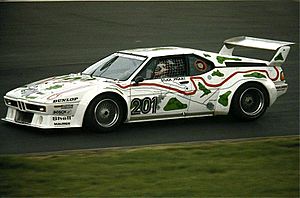
While racing in Formula One, Piquet also competed in the 1000km Nürburgring in 1980 and 1981, driving a BMW M1. He won the 1981 race with Hans-Joachim Stuck.
In 1996, Piquet raced in the Le Mans 24 Hours with Johnny Cecotto and Danny Sullivan, finishing eighth. The next year, his car retired due to an accident. In December of that same year, he won the Mil Milhas Brasileiras with Johnny Cecotto and Steve Soper.
On January 20, 2006, Piquet won the 50th edition of the Mil Milhas Brasileiras (Brazilian 1,000 miles) at the Interlagos circuit. He drove an Aston Martin DBR9 with his son, Nelson Piquet Jr., and other drivers. After the race, a very tired Piquet said he would "never sit in a cockpit again."
Helping Young Drivers
Since 2000, Nelson Piquet has supported the career of his son, Nelson Piquet Jr.. His son raced in the GP2 Series and was a test driver for Renault F1.
Helmet Design
Piquet's helmet is white and red. It has a thick line that looks like the seam on a tennis ball, possibly because his father wanted him to be a tennis player. There are also teardrop shapes on the sides and top. The seam and teardrops were usually red or orange with black outlines. During his time with Lotus, some parts were yellow due to sponsorship. When he moved to Benetton, they changed back to a deep red. His sons, Nelson Jr. and Pedro, use a similar helmet design.
Business Ventures
After leaving motor sports, Piquet started Autotrac in 1992. This company provides mobile data messaging and tracking services for trucks using satellite (GPS tracking). This business was very successful because truck transportation was very important in Brazil.
In 2000, Piquet founded a racing team called Piquet Sports. Its goal was to help his son, Nelson Piquet Jr., race in Formula Three Sudamericana.
Piquet runs several other businesses in Brasília. His net worth is currently around US$200 million.
Personal Life
Piquet was known for being a practical joker. He lived a fast-paced life as a racing driver, earning and losing money in his business deals. He still enjoys competitive sports car racing, but mostly for fun. He was not a fan of street circuits, famously saying that racing in Monaco was like "riding a bicycle around your living room." However, he also said that "a win there was worth two anywhere else."
Piquet's first marriage lasted one year, and they had a son in 1977. His second marriage produced three children, including Nelson Angelo Piquet and Kelly Piquet. He also has another son from a different relationship. He has two children with his current wife, including Pedro Estácio Piquet.
On July 31, 2007, Piquet lost his civilian driving license in Brazil due to repeated speeding and parking tickets. He was ordered to attend a week of lessons to learn safe driving. His wife also received the same sentence. Piquet said, "I think we have to pay for our mistakes."
He was added to the International Motorsports Hall of Fame in 2000. Two racing circuits in Rio de Janeiro (now demolished) and Brasília were named "Autódromo Internacional Nelson Piquet" in his honor. Since his retirement, Piquet has been considered one of the greatest Formula One drivers.
In a 2012 interview, Piquet shared that he was never fully well after his 1987 crash at Imola. The crash caused him to lose about 80% of his depth perception. He secretly visited a hospital every two weeks because he feared his team would not let him drive if they knew. He said he should have won the championship in 1986 and Mansell in 1987. After 1987, he said he drove for the money because his condition made it hard to lead races from the front.
On November 11, 2013, Piquet had heart surgery and made a full recovery.
He currently lives in a large home on a farm near Brasília. It has a private car museum and an airstrip.
Images for kids
See also
 In Spanish: Nelson Piquet para niños
In Spanish: Nelson Piquet para niños


